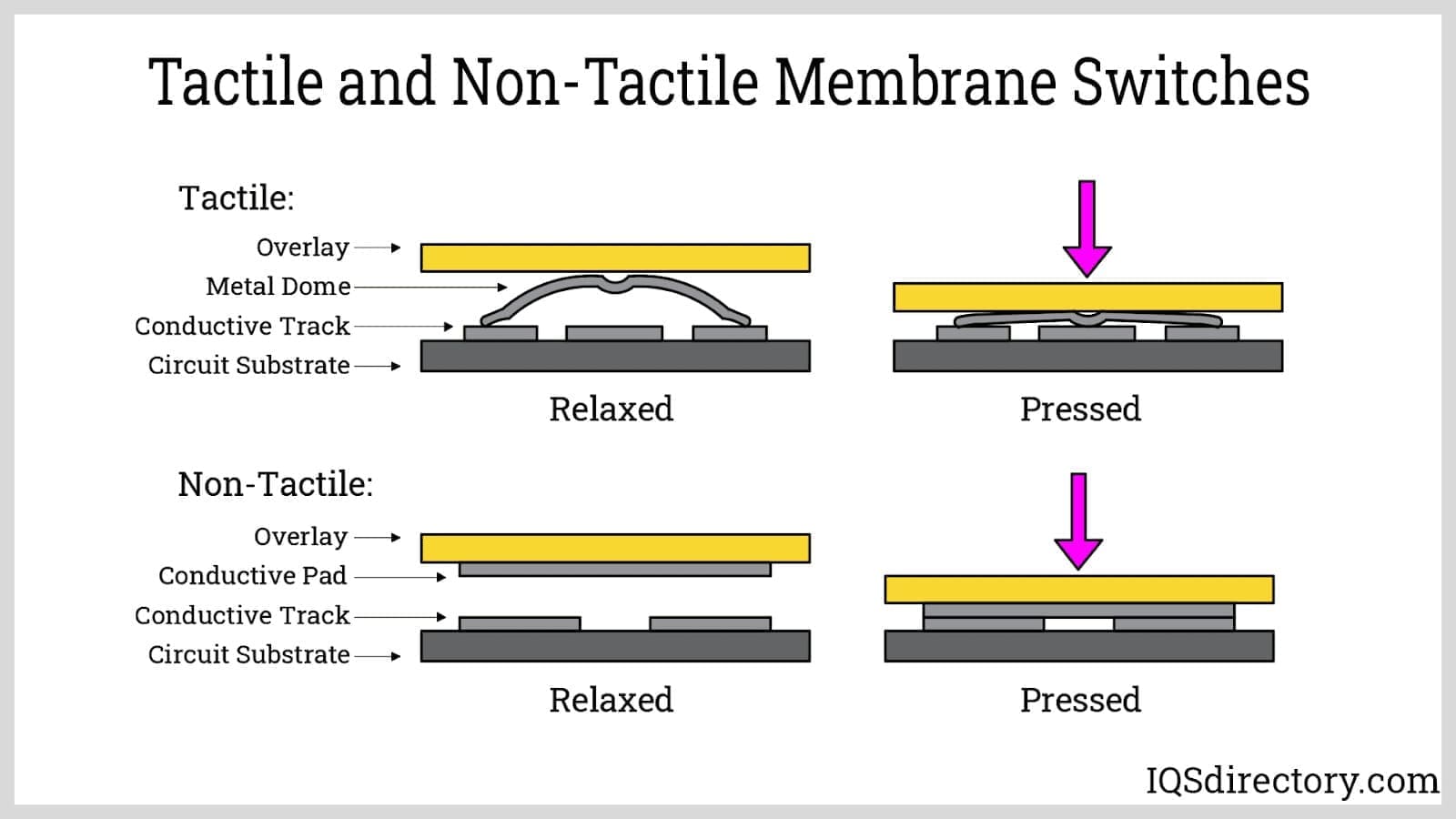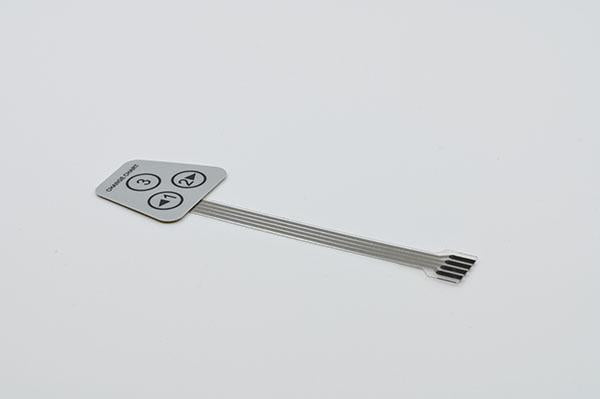Membrane Switch Manufacturer Serving Hospital and Aerospace Industries
Discovering the Manufacturing Refine of Membrane Switch for Various Industries
The manufacturing process of Membrane switches is a complex venture that requires precision and focus to information. From picking proper products to executing extensive quality assurance measures, each action plays an important function in making sure functionality. Numerous industries, consisting of automotive and medical, depend on these components for their one-of-a-kind applications. Understanding the details of this process exposes considerable insights into how these buttons are generated and their impact across varied markets.
Understanding Membrane Switches Over: A Review

Secret Materials Utilized in Membrane Switch Production
In Membrane button production, the choice of vital materials substantially affects capability and sturdiness. Conductive products, adhesives, and finishes play essential functions, while substratum choice affects total efficiency and dependability. Recognizing these parts is vital for optimizing the style and manufacturing of Membrane switches.
Conductive Products Summary
Conductive products play an essential function in the capability of Membrane buttons, guaranteeing trustworthy electrical connections within the gadget. Commonly utilized materials consist of silver, copper, and carbon-based inks, each offering distinct advantages. Silver is preferred for its high conductivity and longevity, making it optimal for applications calling for robust efficiency. Copper, while somewhat less conductive than silver, is a cost-efficient alternative commonly made use of in published circuits. Carbon-based inks offer a functional choice, suitable for applications where flexibility and reduced costs are prioritized, although they have reduced conductivity compared to metal alternatives. The option of conductive materials directly influences the total dependability, life expectancy, and efficiency of the Membrane button, making it a vital factor to consider in the production process.
Adhesives and Coatings
Adhesives and layers are vital elements in the production of Membrane buttons, giving important bonding and protective homes. These products assure that numerous layers of the switch, consisting of visuals overlays and circuitry, stick securely to one another, boosting durability and capability. Typically used adhesives consist of pressure-sensitive adhesives (PSAs) and epoxy-based solutions, which provide strong adhesion and resilience. Coatings, such as polyurethane or acrylic, offer to safeguard against ecological aspects, consisting of moisture, abrasion, and chemicals. Furthermore, finishes can improve responsive feedback and visual charm, adding to the overall customer experience. The choice of ideal adhesives and layers is vital for maximizing performance and longevity in diverse applications across numerous industries, ensuring that Membrane changes fulfill certain functional needs.
Substrate Selection Elements
Substrate selection plays a necessary function in the manufacturing of Membrane buttons, as it considerably influences their overall efficiency and durability. Trick materials such as polyester, polycarbonate, and versatile printed motherboard (FPCBs) are frequently utilized for their unique properties. Polyester is preferred for its cost-effectiveness and resistance to abrasion, making it suitable for applications with high wear. Polycarbonate deals superior clearness and influence resistance, suitable for settings requiring high presence. FPCBs provide enhanced flexibility and are commonly used in intricate styles. The choice of substratum additionally influences elements like thermal security, chemical resistance, and ease of printing. Eventually, picking the appropriate substrate is essential for ensuring the functionality and long life of Membrane changes across various markets.
The Style Refine of Membrane Switches Over
The design process of Membrane buttons is an essential phase that significantly affects the performance and aesthetics of the last item - membrane switch manufacturer. It begins with specifying the details needs of the application, including dimensions, button layout, and tactile feedback choices. Developers have to take into consideration user interaction, guaranteeing that the button is user-friendly and accessible.Next, products are chosen based upon toughness, versatility, and ecological resistance. The assimilation of graphics and branding elements is also important, as it improves visual appeal and communication. Prototyping permits repetitive testing, enabling adjustments based upon customer comments and efficiency evaluations.Additionally, the style needs to represent the electrical elements, such as circuits and ports, guaranteeing integrity and ease of use. Ultimately, a successful layout integrates performance, aesthetic appeals, and customer experience, leading the way for efficient production and lasting performance in various sectors
Printing Strategies for Membrane Changes
The printing methods made use of in go to this web-site Membrane switch production play a necessary role in identifying the end product's quality and functionality. Screen printing offers advantages such as durability and vivid shade application, while digital printing innovations give versatility and precision in design. Understanding these approaches can significantly impact the general performance of Membrane switches in numerous applications.
Screen Printing Benefits
Numerous advantages make display publishing a favored strategy for creating Membrane switches. This approach enables for high-grade, in-depth styles and vivid shades, which are crucial for interface applications. Display printing is particularly reliable for applying thick ink layers, boosting sturdiness and tactile comments. In addition, it uses superb bond to numerous substratums, guaranteeing durability popular atmospheres. The procedure is cost-efficient for big production runs, as it reduces arrangement time and waste. Screen printing sustains a broad array of inks, including specialized and UV-curable choices, making it possible for flexibility in style. Its capability to generate constant outcomes across several units makes it a trustworthy choice for makers blog intending for top quality and efficiency in Membrane button production.
Digital Printing Innovations

Developments in digital printing technology are transforming the production of Membrane switches, providing producers cutting-edge options that boost layout adaptability and efficiency. Digital printing enables elaborate designs and high-resolution graphics, enabling custom branding and functionality without the constraints of typical approaches. This method minimizes arrangement times and expenses, assisting in shorter production runs and minimal waste, making it suitable for organizations with differing demands. In addition, advancements in ink formulations give far better sturdiness and adhesion, ensuring longevity in numerous environments. As industries increasingly look for individualized and complex designs, electronic printing stands apart as an important strategy, setting a brand-new requirement in Membrane button manufacturing. The assimilation of these advancements positions makers to satisfy evolving market requires effectively.
Assembly and Layering of Membrane Switch Elements
Cautious setting up and layering of Membrane button parts are necessary to guaranteeing performance and resilience. This procedure begins with the specific positioning of numerous layers, including the visuals overlay, adhesive, circuit layer, and support material. Each part should be very carefully placed to keep electric stability and customer interface responsiveness.During setting up, conductive traces are applied to the circuit layer, normally made from materials like polyester or polycarbonate. This layer is important, as it transmits signals when pressure is used. The glue made use of for bonding these layers is likewise picked for its capacity to endure ecological stress and anxieties while maintaining a safe bond.Heat and stress are typically applied throughout the setting up procedure to ascertain that the layers adhere effectively without compromising the functionality of the button. Attention is offered to the side sealing to safeguard versus wetness and contaminants, protecting the long life of the Membrane button in various commercial applications.
Quality Assurance Procedures in Membrane Switch Production
Quality control steps play a crucial role in ensuring the reliability and performance of Membrane changes adhering to the assembly and layering of their parts. In the production process, several essential examinations are performed to copyright top quality standards. These include aesthetic examinations for flaws in printing and sticky application, in addition to useful examinations to confirm the responsiveness of each switch.Additionally, ecological testing is done to examine the buttons' durability versus temperature level changes and humidity direct exposure. Makers often carry out analytical procedure control (copyright) techniques to check production consistency, allowing early discovery of anomalies.Furthermore, traceability systems are established to track elements and materials, making certain accountability and promoting remembers if needed. Calibration of tools and adherence to sector requirements are additionally essential to preserving item integrity. Collectively, these quality assurance measures guard the efficiency of Membrane changes throughout various applications, inevitably improving client complete satisfaction.
Applications of Membrane Changes Across Different Industries
Membrane buttons are made use of throughout a diverse range of markets, showcasing their adaptability and adaptability. In the medical field, they supply waterproof and trustworthy user interfaces for gadgets such as analysis tools and mixture pumps, making sure health and simplicity of usage. The auto sector utilizes Membrane switches for dashboard controls, making it possible for seamless interaction between the vehicle driver and lorry systems.In customer electronic devices, these buttons are found in home appliances and portable tools, supplying a streamlined, modern-day aesthetic while improving capability. Industrial applications likewise take advantage of Membrane switches for equipment control board, where toughness and resistance to rough problems are essential.Furthermore, the aerospace and protection sectors make use of Membrane buttons for cockpit instrumentation and communication systems, focusing on integrity and efficiency under severe problems. On the whole, Membrane buttons play an important function in enhancing the individual experience and operational effectiveness throughout different domain names.
Regularly Asked Questions
Exactly how Long Does It Require To Manufacture a Membrane Switch?
The manufacturing time for a membrane switch usually like this varies from a couple of days to numerous weeks - membrane switch manufacturer. Variables influencing this duration consist of design complexity, material accessibility, and manufacturing quantity, all affecting the total timeline markedly
What Is the Regular Lifespan of a Membrane Layer Switch?
The normal lifespan of a membrane switch typically ranges from 1 to 5 million actuations, depending on factors such as worldly quality, environmental problems, and use frequency, considerably affecting sturdiness and general efficiency.
Can Membrane Changes Be Customized for Details Applications?
Membrane switches can undoubtedly be tailored for specific applications. Their style flexibility allows for changes in size, form, colors, and graphics, guaranteeing compatibility with unique requirements throughout different markets and improving performance and customer experience.

Are Membrane Switches Over Eco-friendly?
The ecological effect of Membrane switches varies. Some materials utilized may not be green, while innovations in manufacturing procedures are significantly concentrating on sustainability, intending to decrease waste and advertise recyclable components in their manufacturing.
What Are the Usual Failure Settings of Membrane Buttons?
Typical failure modes of Membrane buttons include delamination, sticky failure, wear and tear from use, dampness ingress, and electric failings. These problems can greatly impact functionality, performance, and lifespan in numerous applications throughout various markets. Membrane buttons can be customized to fit particular design demands, such as capability, shape, and size, making them highly adaptable.The construction usually entails several layers, including a visuals overlay, glue, and a circuit layer, which function with each other to develop a smooth individual experience. In Membrane switch manufacturing, the selection of crucial products significantly affects functionality and resilience. The automotive market employs Membrane switches for control panel controls, allowing seamless communication between the vehicle driver and vehicle systems.In consumer electronics, these switches are discovered in appliances and handheld devices, using a streamlined, modern-day visual while improving capability. Industrial applications additionally utilize Membrane changes for machinery control panels, where durability and resistance to extreme problems are essential.Furthermore, the aerospace and defense industries use Membrane buttons for cockpit instrumentation and interaction systems, focusing on reliability and performance under severe conditions. Membrane switches can certainly be customized for certain applications.